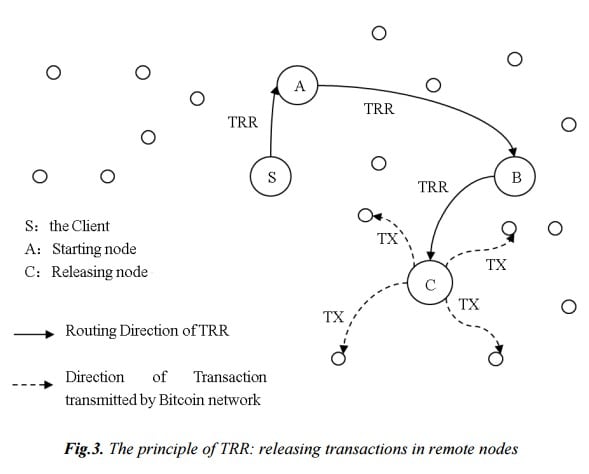
Shenzen University, China researchers released a white paper on September 21st for a proposed Bitcoin anonymity solution inspired by the TOR network.
The white paper abstract begins,
The anonymity of the Bitcoin system has some shortcomings. Analysis of Transaction Chain (ATC) and Analysis of Bitcoin Protocol and Network (ABPN) are two important methods of deanonymizing bitcoin transactions. Nowadays, there are some anonymization methods to combat ATC but there has been little research into ways to counter ABPN. This paper proposes a new anonymization technology called Transaction Remote Release (TRR).
Standard Bitcoin transactions are IP address logged along Bitcoin relays. While solutions such as TOR exist for hiding the originating transaction IP address, the TOR exit node address is still logged and known in the Bitcoin network. The IP addresses of all Bitcoin relays used are additionally logged.
When a TOR user accesses a hidden service, the IP addresses of TOR relays, hidden services, and users are kept anonymous thanks to multi-layer encryption. The Shenzen researchers responsible for TRR are looking to use a similar solution for Bitcoin transactions.
The proposed TRR uses multi-layer encryption to establish anonymous connections between TRR nodes. Only when the last node is reached will the transaction be released to the Bitcoin network. The white paper notes, “Only the client and the last node know the content of the transaction[,] but the last node does not know the IP address of the client.”
There are two documented caveats to this approach however. The first is that support for TRR would need to be added into Bitcoin core. As seen with controversial issues such as the block size debate, this may be a lengthy process.
The second caveat is similar to an already established TOR middleman attack. Because there is no way to verify if a TRR node is trustworthy, the network may be attacked through the use of fake nodes. TRR research notes that the success rate of such an attack declines rapidly as more TRR nodes are in use.
If the project is successfully merged into Bitcoin core, each Bitcoin node would ideally also be a TRR node.
The whitepaper concludes with a solution for directly researching possible attacks against TRR:
For faster implementation and application of TRR technology, setting up a new blockchain or
establishing a Transaction Delivery Network (TDN) are two possible ideas avenues for further research.
DarkNetspace is an independent blockchain of crypto-currency, based on TRR technology to enhance the
anonymity of currency transactions. TDN is an independent network based on TRR technology to
distribute new transactions from any blockchain anonymously, supporting multi-currencies and multiblockchains.








